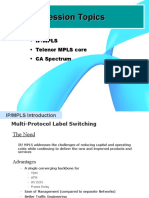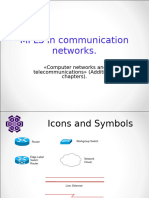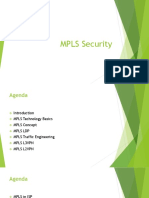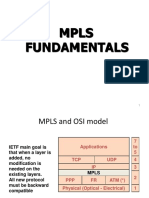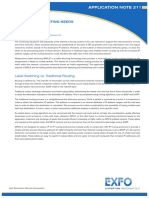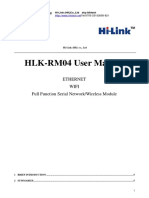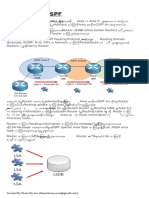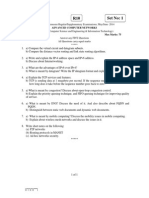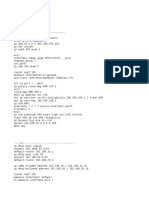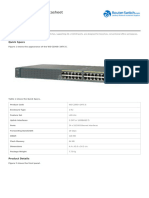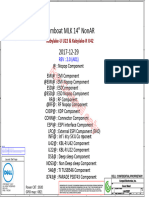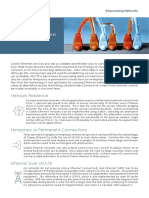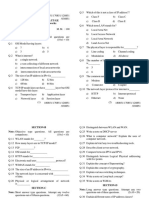MIEEC
Computer Networks
Lecture note 10
Label switching
R. MORLA 2011
�Label switching
R. MORLA 2011
�Switching: circuit, virtual circuit, and datagram
R. MORLA 2011
�Virtual circuits
Built on top of datagram network Each packet follows the same path Can do per circuit:
Admission control Resource reservation
Can do traffic engineering
Specify capacity per VC Choose paths for VCs based on VC capacity and available network resources
Can understand the network usage
R. MORLA 2011
�VC vs. Datagram Networks
R. MORLA 2011
�Forwarding: Longest prefix match
R. MORLA 2011
�Forwarding: Virtual circuits
R. MORLA 2011
�Production network
R. MORLA 2011
�Production network
IP router IP router IP router IP router IP router IP router IP router IP router
Layer 3 IP
Whats the underlying topology?
Point to point? Ethernet switches?
R. MORLA 2011
�Production network
IP router IP router IP router IP router IP router IP router IP router IP router
Layer 3 IP
ATM MPLS
ATM MPLS ATM MPLS ATM MPLS
ATM MPLS ATM MPLS ATM MPLS
Layer 2 ATM/MPLS
SONET
SONET
SONET
SONET SONET
SONET
SONET
SONET
SONET
SONET
Layer 2 SDH/SONET
DWDM DWDM DWDM
DWDM
DWDM
DWDM
DWDM
Layer 1 DWDM
R. MORLA 2011
�Production network
Packet in
IP router IP router IP router IP router IP router
Packet out
IP router IP router IP router
Layer 3 IP
ATM MPLS
ATM MPLS ATM MPLS ATM MPLS
ATM MPLS ATM MPLS ATM MPLS
Layer 2 ATM/MPLS
SONET
SONET
SONET
SONET SONET
SONET
SONET
SONET
SONET
SONET
Layer 2 SDH/SONET
DWDM DWDM DWDM
DWDM
DWDM
DWDM
DWDM
Layer 1 DWDM
R. MORLA 2011
�DWDM network
R. MORLA 2011
�SDH/SONET
R. MORLA 2011
�SDH/SONET
R. MORLA 2011
�ATM
Cells
Virtual connections
Label switching
R. MORLA 2011
�MPLS
Label switching coexists with IP longest-prefix match
R. MORLA 2011
�OSPF, etc.
R. MORLA 2011
�Switching: circuit, virtual circuit, and datagram
R. MORLA 2011
�Switching: circuit, virtual circuit, and datagram
Virtual circuit switching: ATM, MPLS
Circuit switching: Digital synchronous multiplexing (SDH, Sonet), DWDM
Datagram switching: CIDR lookup OSPF, BGP
R. MORLA 2011
�Label switching: ATM evolution to MPLS
Asynchronous Transfer Mode Multiprotocol Label Switching
R. MORLA 2011
�ATM
Designed to become the next step after ISDN, BISDN, etc. Designed to offer integrated network services, meaning:
Constant bitrate, variable bitrate Audio, video, etc. Single network infrastructure, multiple applications
Based on fixed-size packets (cells)
With adaptation protocols for each application
R. MORLA 2011
�Applications => cells => single transfer mode
R. MORLA 2011
Network
�Applications => cells => single transfer mode
Cells
R. MORLA 2011
�ATM packet switching
R. MORLA 2011
�ATM virtual paths and channels
R. MORLA 2011
�ATM
Vision 1
Replace IP Applications/hosts all become ATM-speakers
Vision 2
Provide services at the core network
ATM overlay network
Traffic engineering, QoS
Overall
interesting ideas, wrong approach
R. MORLA 2011
�Label switching: Overlay vs. peering
Direct peering of routers
Overlay of virtual circuits
Two networks to manage!
R. MORLA 2011
�MPLS
Take the label switching concept
Good for:
Traffic engineering Network control and planning
Apply it to the IP network
Not as an overlay network
R. MORLA 2011
�MPLS encapsulation format
Shim layer
2.5 layer
MPLS data encapsulated between Layer 2 and Layer 3
Ethernet and IP
Labels may be pushed/popped at intermediate routers
R. MORLA 2011
�MPLS scalability via aggregation
One label switched path (LSP)
Can aggregate multiple IP flows
Aggregation on Edge
Label Switch Router (LSR) border
R. MORLA 2011
�Aggregation in core
R. MORLA 2011
�MPLS tunneling
R. MORLA 2011
�MPLS Control Plane
Label Distribution Protocol
Destination-based / control-driven Computed according to IP route
R. MORLA 2011
�MPLS LDP control-driven example
R. MORLA 2011
�MPLS Explicitly-routed LSP
LSP specified by operator or network management system Route specified in LDP setup message
Message sent to all LSR in the route Each LSR sends label request to next-hop LSR
Path independent of IP routes
Opens the door to traffic engineering
R. MORLA 2011
�Constrained-based Routed LDP CR-LDP
LSR A requires route/resources to LSR C 1. LSRA computes path to LSR C 2. LSRA reserves resources, sends label request and traffic parameters to LSRB/C 3. 4. LSRC checks for resources. If available send mapping message to LSRB 5. LSRB does the same, mapping original LSP id
R. MORLA 2011
�MPLS with RSVP
Resource Reservation Protocol Similar to CR-LDP except resources are checked on the return path
R. MORLA 2011
�RSVP vs. CR-LDP
State-full vs. state-less CR-LDP
uses TCP Hard state
needs explicit label unbinding message
RSVP
Uses UDP Soft state, needs to periodically refresh state Detects changes automatically
R. MORLA 2011
�Generalized Multiprotocol Label switching
R. MORLA 2011
�TO THINK
MPLS applies to packet switching
Can we apply the same label switching concept to the rest of the network?
Time slots (TDM) Wavelengths (DWDM) Physical fibers
R. MORLA 2011
�Goal
Fast and automated way to create On-demand circuits
R. MORLA 2011
�Network hierarchy
Fiber
WDM TDM
Packets
R. MORLA 2011
�Switching Hierarchies
Packets TDM WDM Fiber WDM TDM Packets
Fiber switching switching Timeslot switching Packet switching
R. MORLA 2011
�Switching capabilities
Timeslot, TDM(SONET/SDH) Wavelength (lambda) Waveband (sets of lambdas) Port (fiber) switching
R. MORLA 2011
�Generalized label
Fiber id in a fiber bundle, Waveband in a fiber Wavelength within waveband/fiber Timeslot within a wavelength MPLS/ATM packet switching label
R. MORLA 2011
�Hierarchical LSP setup
Un-established connections Bi-directional connections
R. MORLA 2011
�Hierarchical LSP setup
R. MORLA 2011
�MPLS vs. GMPLS issues
Control and data could be delivered on different paths Labels must have meaning (map to resources) Stacking: tunnels in packet networks, physical hierarchies for others Set/Delete paths can be more complex than removing labels from forwarding table
R. MORLA 2011
�MPLS vs. GMPLS issues
Label set
No wavelength conversion Same wavelength pool across the optical network Contention on wavelengths
R. MORLA 2011
� How are virtual circuits implemented over datagram networks? What are the advantages and disadvantages of virtual circuits? What are the technologies typically used in a production network? Why is MPLS called a 2.5 layer protocol? How does MPLS scale? What are the advantages and disadvantages of a hardstate vs. soft-state protocol? What are the network technologies that are managed by the GMPLS protocol? What does label stacking mean in GMPLS?
R. MORLA 2011
�HOMEWORK
Review slides Read from Kurose
Section 5.8 Link virtualization
Do your Moodle homework
R. MORLA 2011















